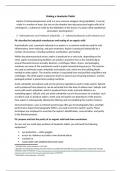Making a Headache Tablet
Aspirin (2-ethanoyloxybenzoic acid) is a very common analgesic drug (painkiller). It can be
made in a number of ways, but one on the simplest two-step processes begins with oil of
wintergreen, a substance made by the distillation of the leaves of a plant called Gaultheriae
procunbers (wintergreen).1
2−hydroxybenzoic acid +ethanoic anhydride →2−ethanoyloxybenzoic acid+ ethanoic acid
P6: describe the industrial manufacture and testing of an organic solid
Acetylsalicylic acid, commonly referred to as aspirin, is a common medicine used for anti-
inflammatory, fever-reducing, and pain treatment. Aspirin is produced industrially by a
number of processes, including synthesis, purification, and testing. 2
Within the pharmaceutical sector, aspirin is produced on a vast scale. depending on the
need, aspirin manufacturing facilities can produce anywhere from a few hundred kg to
several thousand tonnes annually. Reactors, centrifuges, filters, dryers, and packaging
machines are some of the machineries used in aspirin manufacturing process. The reactors
are used to synthesise acetic anhydride and salicylic acid, which are the building blocks
needed to make aspirin. The reaction mixture is separated from and purified using filters and
centrifuges. The dried aspirin is placed in dryers to extract any remaining moisture, and the
packaged product is placed into packing machines.
Acetic anhydride and salicylic acid are the primary ingredients used to make aspirin. Salicylic
acid is produced from phenol or can be extracted from the bark of willow trees. Salicylic acid
reacts with acetic anhydride, which is produced from acetic acid and utilised as an
acetylating agent. Salicylic acid and acetic anhydride react in the presence of a catalyst, such
as sulfuric acid, to produce aspirin. Acetic acid and aspirin are byproducts of the process.
Pure aspirin is subsequently obtained by filtering and recrystallising the reaction mixture.
Several techniques, such as infrared spectroscopy (IR), gas chromatography (GC), and high-
performance liquid chromatography (HPLC), are used to test the aspirin’s purity. These
techniques are employed to ascertain the aspirin’s identification, concentration, and purity
in the finished product.
P5: prepare and test the purity of an organic solid and draw conclusions
To carry out our multi-step synthesis of headache tablet, you will need the following
equipment:3
eye protection – safety goggles
access to a balance accurate to two decimal places
crushed ice
wash bottle with distilled/deionised water
1
INTRODUCTION, school worksheet, 31/05/2024
2
RESEARCH THE INDUSTRIAL PRODUCTION AND TESTING OF ASPIRIN AND DESCRIBE THE SCLAE, EQUIPMENT, TESTING AND THE RAW
MATERIALS USED TO PRODUCE IT, https://www.studocu.com/en-gb/messages/question/2960629/research-the-industrial-production-and-
testing-of-aspirin-and-describe-the-scale-equipment-testing, 01/06/2024
3
EQUIPMENT, school worksheet, 31/05/2024
, clean, dry sample tube and lid
conical flask (100cm3)
2 x measuring cylinders (10cm3)
spatula
stirring rod
beaker to contain ice and water to cool the mixture (250cm3)
apparatus for filtration under reduced pressure
watchglass
sample tube and lid
glass marker pen
ice
chemicals provided:
Label Identity
Ethanoic Anhydride Ethanoic anhydride, (CH3CO)2O – liquid (l)
Concentrated H2SO4 Concentrated sulfuric (VI) acid, H2SO4 –
aqueous (aq)
Concentrated ethanoic acid Concentrated (glacial) ethanoic acid,
CH3CO2H
Health and Safety:
- wear eye protection at all times
- when dealing with chemicals, use them with care and within the interior of a fume
cupboard
- if necessary, wear gloves at all times
- keep a safe distance, when instructed to
- use all glassware with caution to avoid any accidents
- keep any liquid away from any electrical appliances, to prevent electrical shock
Method:
1. I transferred 2g of the 2-hydroxybenxoic acid into the sample tube. Then I measured
and recorded the mass of the sample tube and sample.
2. I then transferred the 2-hydroxybenzoic acid into a 100cm3 conical flask and
measured the mass of the sample tube again.
3. Next, I measured 4cm3 of ethanoic anhydride into a 10cm3 dry measuring cylinder
and poured it into the conical flask.
4. After, I added five drops of concentrated sulfuric (VI) acid to the flask and shook it
gently from side to side for about 10 minutes.
5. Then I cooled the conical flask in a large beaker containing ice to complete the
crystallisation.
6. Using a clean measuring cylinder, I measured 4cm3 of cold glacial ethanoic acid and
added it to the reaction mixture to dilute it.




